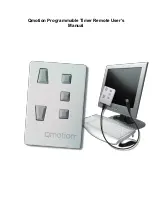
Sidus - electronic timer
4/11
Timer
Duration and resolution of the functions
Each of the 6 available functions (F1 to F6) has a programmable time interval. The range
for F1 and F2 is 0.01 to 9.99 sec. The range for F3 to F5 is 0.1 to 99.9 sec. and the range
for F6 (DT) is 1 to 720 sec.
The intervals programmed for the first 5 functions sum up to each other. For
convenience the interval for F6 (DT), is referred instead to the start of the Timer. It
follows that the minimum interval for the DT will match the sum of the previous 5
functions rounded in excess to the integer second.
States of the Timer
Like a clockwork timer, this Timer goes across different predefined states. The pair of
colored leds on be Timer board shows the current state of the Timer according to the
following scheme:
1. RED ON: Timer charged – disc at the beginning of its travel
2. GREEN ON: Timer discharged – disc at the end of its travel
3. Flashing RED (fast): Timer armed, the timing sequence will start at start switch
release
4. Flashing RED (slow): timing sequence in progress
5. Flashing GREEN: disc repositioning in progress
6. Flashing RED and GREEN (3 flashes): Timer battery pack to be recharged
Using the Timer
The function of the start switch depends on the current state of the Timer. Starting from a
discharged Timer (GREEN led ON, disc at end of its travel) the functions are:
•
Resetting the Timer - bring down all the arms, press the start switch until the GREEN
led starts flashing, and then release it. The disc quickly turns back in steps to the
beginning of its travel and the RED led turns ON
•
Starting the Timer - press the start switch until the RED led starts flashing fast. The
Timer is armed and the timing sequence will start as soon as the start switch is
released. During timing the RED led flashes slow and the disc rotates of one step to
release an arm at the end of each programmed function until it reaches the end of its
travel and the Timer turns off
The timing sequence can be early terminated by pressing the start switch: all the
pending functions are executed in steps and the disc returns to the end of its travel
Automatic switch off and Timer battery check
When the Timer goes to sleep to save power, its state and all the internal data are
retained. When it wakes up, if battery voltage is found insufficient, it flashes both the leds
(three times) and goes back to “sleep” to prevent the batteries from being harmed.





























